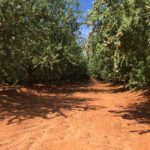
During the first two weeks of November, I was able to attend the once-every-four-years International Research Congress on Pistachios and Almonds. This meeting was held in Adelaide, Australia in which almond and pistachio researchers (as well as some growers) attended to discuss recent research within these crops. Prior to the conference, I toured some orchard operations in the Mildura area. These orchards had the look and “feel” of California orchards and yields in the 2700-3000 lbs/acre. Through the visits and discussions with my various hosts, issues that many of the operations were trying to manage were similar but different to what we experience within California. Below are a selection that I found interesting and thought I would share.
Good water management can compensate for limiting soils. Across all of the properties I visited, the soil profile was very shallow with 18-24″ of sand before hitting a limiting layer of clay. To make matters worse, the layer of clay often had a very high pH (>9) and boron (>3.0 ppm) – which would kill almond trees. These conditions reduced the rootzone to the sand profile which has limited water and nutrient holding capacity. To compensate for these “shallow soils,” most orchards are planted on a raised bed and irrigated daily with double drip systems to match the tree’s water demand for that day. The water applied does not exceed the holding capacity of the 24″ of soil to prevent root movement into the deeper toxic soil. This practice also prevents excess water from running off or creating a perched water table.
This was an “eye-opening” experience for me. We generally have the luxury of deep soils within California in which we can irrigate deeply, less frequently. These irrigation practices, however, produced tree growth and yields which were comparable to California orchards. This observation suggests that soils with a shallow limiting layer could be planted if good water management practices are employed.

Irrigation infrastructure for a single operation is often very developed. Nearly all operations are using surface water which has variable flows. This means that a very large infrastructure is needed to keep an orchard irrigated, including pumps, miles of pipe, and reservoirs to move water from the rivers (usually the Murray) to the fields. To optimize water use efficiency within the field, most operations use control boxes and radio controlled valves to help schedule and switch irrigation blocks. All water use is metered. Within the area I was touring, there was no groundwater pumping. Excluding the pumping regulation, the infrastructure development reminded me a lot of some operations along the Westside of the San Joaquin Valley of California.
Labor is expensive. When calculating for salary and benefits, the minimum wage is about $28 AUD, which is about $22/hour USD. Labor is hard to find and skilled labor is even more of a challenge. This has led to the implementation of more technology across the field to help with manual tasks (i.e. irrigation controller boxes to switch irrigation from block to block). It also has led to the reduction of labor intensive cultural practices, which has impacted pest management. With the changes to labor wages within CA, my guess is that these technologies may find an increase in use.
The industry is learning how to manage Carob moth and Carpophilus beetle. These two insects feed on new crop almonds causing yield loss and consumer issues. Carob moth appears to be very similar to Navel Orangeworm (NOW), but the population dynamics are slightly different. We don’t have the damaging species of Carpophilus beetle in California, but this insect essentially “drills” a small hole into the almond and lays an egg which hatches and consumes the kernel. Both of these insects overwinter in mummies and appear to be able to be managed by good sanitation. Interestingly, operations that have been able to manage these pests without pyrethroids have been able to avoid the use of miticides.
Although many wouldn’t know it, we have Carob moth in California. This moth pest doesn’t create much of an issue which may be due to competition with NOW or the general standard of sanitation that we have across the industry.
Weather patterns are different. Total rainfall is similar to areas within the Sacramento valley (~20″/year). Rainfall is a bit heavier in the winter, but frequent summer rains occur with the risk of heavier rains increasing in the fall. This has created issues with certain diseases such as rust and hull-rot which increases the use of fungicides. It also has created issues with harvest which is being managed in different ways including earlier harvesting varieties, technology to increase drying efficacy and costs and implementing a faster harvest process.
Discussions in managing hull-rot were generally pretty thorough. The high incidence of disease creates stick-nuts and sanitation issues, which then creates insect management problems. Most orchards with severe problems were over-fertilizing their trees (mid-summer leaf N was greater than 3%), with trees in low-lying areas showing the most damage. Although fertilization practices needed adjustment, the conversations regarding the use of product sprays not commonly used in California were of interest and tests need to be developed here.
Processing infrastructure is not as developed. Currently, there is about 100,000 acres of bearing almonds in Australia with an additional 20,000-30,000 (or more) non-bearing acres on the way. The crop from this production is processed by five handlers. In comparison, Merced County has about the same number of bearing acres, in which we have about a dozen processors and handlers. This lack of processors and distance between the farms and facilities increases transportation costs for farmers as well as the lack of processors leads to limited processing schedules, stricter fee and return schedules.


Nick Edsall
December 2, 2017I am curious what the boron levels are in the surface water being applied? Is the high boron a problem only in the soil, or is it high in the irrigation water too?
David Doll
December 11, 2017Hey nick,
Good question! The water is low in boron, which helps reduce accumulation. From what I gather from their agronomists is that the boron is tied up in the clay layer due to the high pH. If the soil pH was lower than 8.5-9, there would be a good chance that the trees would show signs of toxicity.
David